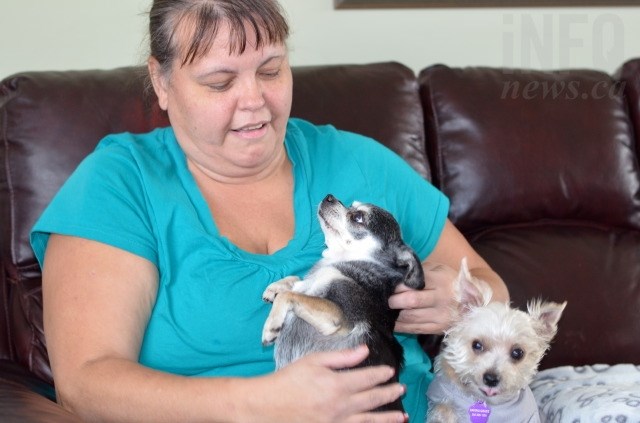
Kimberly Gillis, Saving Grace Dog Rescue founder and president.
(CHARLOTTE HELSTON / iNFOnews.ca)
December 05, 2015 - 10:30 AM
"I THINK SHE IS A DOG FLIPPER AND NOT SOMEBODY WHO REALLY CARES ABOUT DOGS"
VERNON - After 16 years working in animal welfare, Patricia Zerr was never asked to steal a dog — until the winter of 2014 after she got involved with a Vernon-based dog rescue.
She remembers driving to a home on a First Nations reserve near Kamloops with Saving Grace Dog Rescue founder and president Kimberly Gillis. They had already taken in nine surrendered puppies and Gillis came to Kamloops to pick up the litter then asked Zerr to show her where the puppies came from. Zerr thought the purpose of the visit was to follow up with the owner, but what Gillis said as they neared the driveway made her jaw drop.
“She said ‘no, we’re here to scoop momma dog,’” Zerr says. “I said, ‘pardon?’ She repeated herself and I said ‘we can’t steal someone’s dog out of their yard.’ She said, ‘damn rights we can.’”
Zerr is one of five former volunteers speaking out about numerous issues at the shelter. All say they simply wanted to help animals and volunteering at a ‘dog rescue’ sounded right. But our investigation reveals the rescue may not be the saving grace it claims to be. The volunteers we spoke with say RCMP reports and complaints with the SPCA have been made, but seeing little action, they saw no other recourse than taking their experiences to the media to expose the rescue.
As Zerr and Gillis approached the house that winter night, the lights were on but the mother dog wasn’t outside, to Zerr's relief. She recalls Gillis scanning the yard for the dog, and saying, ‘Oh, too bad,’ before turning around.
It wasn’t the first time Gillis had talked about ‘scooping’ dogs, Zerr says. A few weeks earlier, Zerr mentioned seeing a dog left outside during a cold snap and Gillis instructed her to ‘just get it.’
“I said, ‘I can wait until the owner is back and touch base about what supports we can put in place’ and she said, ‘no, that’s not what I’m asking.’ She said, ‘I’m asking you to grab the dog, do you think you can?’”
Zerr, who has previously worked with the SPCA, refused to take the dog.
“In no way would I steal someone’s dog and risk getting bit or shot trespassing on someone’s property,” Zerr says. “No matter how destitute the situation is, there’s channels you need to go through, you cannot scoop someone’s dog out of a yard.”
Zerr never witnessed Gillis steal a dog, but was concerned about being asked to do so. Other things were happening too that made her worried — lightning-fast adoptions, missing donations and inconsistent veterinary care.
“There were red flags after red flags coming up for me. At first I thought I was just being extra hyper vigilant, and then I thought, something’s going on here, something’s not adding up,” Zerr says.
A SAVING GRACE?
Saving Grace Dog Rescue was founded in July 2014 by Gillis. Like many other rescues popping up across the country, it is a home-based operation run with a network of fosters who care for the animals until an adopter is found. Our investigation revealed vast differences in how such operations are run, and discovered there are no provincially or federally mandated standards of practice. The dog rescuing industry is, in essence, an honour-based system with little, if any, oversight.
We reached out to Gillis and she agreed to meet with us Nov. 10 at a volunteer’s house, not her own. During the interview, she spoke willingly about the rescue, which she described as an amazing group of 40 unpaid volunteer fosters and a full board of directors, also unpaid. All proceeds from fundraisers and adoption fees go to the dogs, she said.
She said she was already rehoming dogs for friends and thought she might as well start up an actual rescue group. She began by creating a Facebook page and getting some foster volunteers together. The rescue’s first efforts involved bringing in Chihuahas from high-risk kill shelters in the U.S., Gillis said, but that turned out to be ‘not feasible’ and the focus was redirected at local animals.
Establishing the rescue was a learning curve, she said, and it wasn’t until a few months later that she got the group registered as a non-profit society and set up a bank account for Saving Grace.
“When I first started, I did lots of research into other rescues, even across the country and down in the states, and wherever else because everywhere has something you can use,” she said.
But it didn’t take long for the practices to get called into question by volunteers. Gillis said ‘bullying and slander’ became an ongoing issue as the rescue’s policies came under attack by ‘naysayers’ on social media.
“We’ve had people that used to be with us that turned on us. Two of them because we would not foster out to them anymore and two of them because we did say, 'this is what we’ve done, we are doing it right….' It amazes me what comes out,” she said. “I’m held to the highest standards and being human, I get emotional sometimes.”
She said revisions are constantly being made to the rescue’s policies and that suggested changes are considered.
But that was the last we heard from her. Multiple attempts to contact her by phone and email for follow-up questions as our investigation continued were met with silence.
When we knocked on her door Dec. 2, someone who described herself as a friend and volunteer with the rescue told us Gillis was sick and couldn’t talk to us. The same day, a notice was posted to the Saving Grace Dog Rescue Facebook page stating Gillis stepped down as president due to health issues.
That Facebook page has since been removed from public view and when contacted, a volunteer told us all the rescue’s members have resigned. A source says the rescue is shutting down completely amid entirely new and as yet unsubstantiated claims.
Gillis still hasn’t responded to us. Requests to speak with the society’s board members, including the vice-president and treasurer, to find out more about the situation and the rescue’s closure have also been ignored.

Dogs posted for adoption with Saving Grace.
Image Credit: Saving Grace Dog Rescue
WORKING WITH SAVING GRACE
It wasn’t hard to become a foster for Saving Grace, former volunteers say. Jenn Guthro says she met Gillis over Facebook while looking to adopt a rescue dog for herself. A couple months later, in August 2014, Guthro got a message asking if she’d like to foster a new rescue dog. Guthro agreed to help. They met in an A&W parking lot and Guthro filled out a foster application on the spot.
“She basically threw the dog in my truck. She didn’t do a home check. That was one of my first red flags,” Guthro says.
Guthro took the dog under the belief it was good with other animals and people, but soon discovered otherwise — it wasn’t good with cats and was leash-aggressive. She says Gillis told her not to post pictures of the dog on Facebook, not to tell anyone of the dog’s location, and to use a fake name if questioned about the dog.
Not long after, Guthro was asked to join the Saving Grace board and to sign some paperwork so the rescue could get status as a non-profit. According to records, Saving Grace was incorporated as a non-profit society on Oct. 10, 2014.
Guthro, who had no prior experience running a rescue or working with animals, was appointed the Saving Grace foster coordinator.
Another dog she fostered what she considered a severe case of worms and despite Guthro’s insistence the dog needed to see a vet, Gillis responded by dropping off some medication herself. Gillis often took canine health care into her own hands, stating she was a nurse so she knew what to do, volunteers say. It was the wrong medication, Guthro says, and the worms only got worse.
Guthro also recalls dropping off a surrendered dog she’d picked up along with a $40 donation from the owner made out to Saving Grace Dog Rescue. She remembers Gillis being angry, and saying she couldn’t cash the cheque because it wasn’t made out to her personally. There was no separate account set up for the rescue itself at the time, Guthro says.
Guthro eventually confronted Gillis about how the rescue was being managed, then was blocked and deleted from the Facebook group and told she was no longer welcome to volunteer at Saving Grace.
Another volunteer, Terri Rosart, was also surprised at not being more thoroughly screened prior to becoming a foster. Unlike another Okanagan rescue she volunteers for, there was no home check and no request for references.
Rosart grew more concerned when Gillis showed up at her house to remove stitches from a dog recently flown in from the United States.
“Kim asked me for a pair of kitchen scissors — that for me was like, holy-hannah, you don’t do that,” Rosart says. “She informed me she was a nurse and knew what she was doing. I still wasn’t comfortable with it…. I still don’t know why I didn’t say ‘no, take her to the vet.’”
Later, the same dog started having ‘head shakes’ and Rosart decided — without asking for Gillis’ permission — to take her to the vet.
“I called her and said I’m on the way to the vet, please make arrangements for payment,” Rosart says. “Do I think Kimberly would have taken care of it? No. I think she would have said watch her and see.”
Gillis did cover the vet bill, but when Rosart started running low on the prescribed medication, Gillis told her to halve the dose. When Rosart took the dog back to the vet for a follow up appointment, she was criticized for halving the dose and told the medicine wouldn’t be effective.
Some of the allegations are perhaps attributable to growing pains and the growth of a start-up rescue with an inexperienced operator — but Rosart doesn’t buy that. If Gillis was really trying to help the dogs, why didn’t she start small, Rosart says.
“If she’s doing it for the animals how come you have 27 animals up (for adoption) at the same time? Why do you keep having dogs brought in, why do you keep having dogs returned? She gives dogs away from meet and greets and doesn’t do home-checks.”
Rosart also noticed that any time a dog was posted for free or for cheap on Castanet or Kijiji, Saving Grace would ‘jump on it.’
“I think she is a dog flipper and not somebody who really cares about dogs. I don’t want anything to do with that, I think it’s morally wrong.”
NO HOME CHECKS, NO BEHAVIOUR ASSESSMENTS
Tara Holliday met Gillis while looking for a dog sitter, and says it wasn’t long before she was asked to step up as the vice-president of the rescue in July 2014. From the beginning, she was concerned that fosters and adopters weren’t being adequately screened by the society. She often saw dogs surrendered one day and adopted out the next with no time for vetting or behavioural assessments, or background checks with the new owners. The emphasis seemed to be on taking in and adopting out as many dogs as possible, as quickly as possible, she says.
“I saw several emails where people inquired about dogs all the way from the coast saying they were interested. Kim said, ‘It’s yours, it’s available. Just send the email transfer money,” Holliday says. “She’d ask around on buy and sell pages to find people (driving) down there.”
A copy of the rescue’s certificate of incorporation under B.C.’s Society Act says the group’s purpose is, among others, to provide vet care as needed, including up to date vaccinations, deworming, spay or neutering, and a health exam, as well as to thoroughly screen all fosters and adopters prior to placing a dog.
Holliday admits things may have changed since she left the rescue around February 2015, but says when she was there, email records were constantly disappearing from the society’s account.
“Instantly, anything any bit suspicious would be deleted,” Holliday says. “I contacted Kim and said a bunch of these emails are gone, and Kim said things were getting hacked.”
Holliday was getting concerned about the sheer volume of dogs coming into the rescue, many of them never even getting posted to the website or Facebook page before being adopted. When we met with Gillis Nov. 10, she said roughly 157 dogs had been rehomed through the rescue. A tally counted up by the volunteers is much higher. Holliday says some 176 dogs were posted as available for adoption between July 2014 when the rescue started, and about May of 2015, but she’s also aware of at least another 50-70 dogs that were brought in, sold and never even advertised during that time period. Many of the dogs were brought in from Los Angeles, others from First Nations reserves in northern B.C. A small dog rescue in Los Angeles Gillis reportedly networked with has not returned our calls or emails.
With adoption fees in the neighbourhood of $350-$400, conservative math puts the rescue’s income over that ten-month period at nearly $80,000. That’s not counting numerous fundraising initiatives put on by the rescue. It also doesn’t account for additional adoption fees obtained for dogs that came back to the rescue and were re-homed. We couldn’t verify whether adoption fees were reimbursed when dogs were returned, but the volunteers say they rarely saw that happen.
It’s unclear how much money went to vet bills. The rescue’s website states all dogs that come in receive a vet check ‘if required’ and that every animal will be spayed or neutered prior to adoption.
Under the Society Act of B.C., registered societies are required to keep financial statements and make them available to the public upon request. Our request for such records has not been returned.
A SECOND CHANCE LEADS TO TRAGEDY
The worst part, Holliday says, was seeing dogs constantly being shuffled around, their shot at a forever home sabotaged many times over by false information. Adopters were misled about the dogs, and frequently told they were friendly, and good with people and pets, when they weren’t, Holliday says. Dogs were often returned to the rescue when things didn’t work out and were readopted, sometimes multiple times, and always for another adoption fee.
“I got suckered into thinking I was helping the dogs, until I couldn’t watch it anymore,” Holliday says.
One such miscommunication led to a dog being adopted out to someone looking for a farm dog to guard against predators. The new owners posted on Facebook a few days after adoption asking for advice because they were having doubts about the dog’s advertised ‘farm dog experience.’ They had the dog tethered at night, where it howled in distress. Someone replied that it was not right to tie dogs up, particularly when predators are around, leading the new owners to leave the dog loose. It ran off and was shot that night by a neighbour.
Had a proper home check been done to ensure the dog wouldn’t be left tied up overnight, or perhaps even if a better match had been found for the adopter, volunteers believe the situation could have been prevented.
In part two of our series tomorrow, we will look at regulations for rescue groups — or the lack of regulations animal advocates say are missing from the industry.

Dogs posted for adoption through Saving Grace.
Image Credit: Saving Grace Dog Rescue
To contact a reporter for this story, email Charlotte Helston at chelston@infonews.ca or call 250-309-5230. To contact the editor, email mjones@infonews.ca or call 250-718-2724.
— This story was edited at 7:43 a.m. Dec. 6, 2015 to correct that Patricia Zerr was not an investigations officers with the SPCA. She did however perform a number of duties while working for the SPCA. We apologize for the error.
News from © iNFOnews, 2015